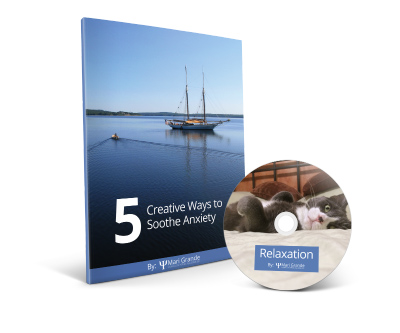
EMDR Therapy Doesn’t Have to Be a Mystery
EMDR as a tool used in therapy has gained increasing popularity over the years. Yet, exactly what it is and what really happens when it’s practiced remains mysterious.
Some will talk about it being used with war Veterans to help with trauma (which is true), but its wider reach is still elusive.
Because I’ve seen such great results with EMDR Therapy for people from all walks of life, I wanted to take time to talk about what it is and share more about how it works on a practical level.
Let’s talk about trauma for a minute.
When something happens that is too much, too soon, and too fast it becomes a traumatic experience. It overwhelms our nervous system, our psyche is caught in the crossfire, and usually “checks out” as a way to protect us.
Often, people aren’t aware they’ve experienced trauma when it’s something that feels more common, like a car accident. Car accidents happen to many people, so the impact of it seems like it should be okay.
Stress, trauma, or things that frighten you, can get stuck in parts of your brain, which can then block your rational thought. Or more specifically, it can interfere with your ability to react when similar situations arise.
It’s true. Experiences that are traumatic, scary, and intense activate the limbic system. The emotional, survival part of the brain. To get technical for a minute, the Amygdala is part of the limbic system and is our “alarm center”, where we process fear. If there is too much too soon or too fast, we experience trauma. When emotions are too high, our thinking brain goes offline and we just want to survive, and rely on primitive instincts to do that.
Emotions that are too much to bear will be felt in the body and “hide” or get stuck in our brain. Those experiences need to move from that part of the emotional limbic part of the brain and interact with the thinking prefrontal part of the brain.
Take the car accident example. Say you were driving on the freeway and you saw brake lights and suddenly realized you needed to stop. Maybe you stopped just in time but the car behind you didn’t and hit you at full speed! It’s scary, to say the least (trauma)!
Over time you heal, you get your car fixed, but the next time you go on the freeway you may experience anxiety. Or when you see brake lights you might feel almost paralyzed by fear reliving that experience.
That is because the experience of the accident is still in the part of your brain that reacts, not integrated with the part of the brain that makes rational decisions.
That response is “fight or flight” mode. (see: How the Fight-or-Flight Response Works).
There is good news though. You can move those experiences out of the emotional memory part of your brain and engage your thinking part of your brain. You still have the memory, but your feelings about it can change.
Fight or Flight and Trauma, Lessening the Trigger
One way to help lessen traumatic experiences is by desensitizing – lessening the “trigger” so to speak.
Eye Movement Desensitization and Reprocessing (EMDR), is a great tool used by trained EMDR Therapists to help you move the trauma from the reactive part of your brain to the thinking part so that you can make more rational decisions (decisions from the part of your brain that isn’t triggered into fight or flight mode).
EMDR Therapy came onto the scene in 1987, developed by Francine Shapiro, and has been allowing people breakthroughs they may not experience otherwise.
In the car accident example, the goal would be to go from feeling triggered each time you see brake lights to being able to see them and be in your “rational brain” to decipher – do I need to stop completely or just slow down?
The car accident analogy is easy to understand but trauma can be much more complex. Trauma can also be prolonged abuse in a relationship (relational trauma), feelings of inadequacy, overly critical parents, feelings of abandonment and so much more.
Moving trauma out of triggering fight or flight can be very beneficial.
EMDR Therapy is lesser-known but widely used to help with trauma.
EMDR is a process therapists use involving imagery and sensation. For instance, when you are ready, an EMDR therapist will have you “revisit” the incident that created the trauma, have you hold the image in your mind, along with associated thoughts and beliefs, feel it in your body, in present time, and “loosen” it with bilateral stimulation. Whether moving your eyes from right to left, tapping on your knees, or some other right/left stimulation, this activates neural networks in your brain so you experience an event in a new way, and can desensitize the experience as thus “reprocess” a trauma. EMDR is an 8-phase treatment approach, so this is a simplified explanation to help with understanding EMDR (See: The 8 phases of EMDR Therapy for more of an in-depth look at each phase).
This is not something you want to try at home and instead you’ll want to find a licensed EMDR Therapist near you because allowing the emotions to surface is an important part of the process and having a trained support person there to support you is key.
A wide variety of people from first-time mothers to war veterans have reported relief from anxiety and a reduction in fight or flight symptoms, using EMDR.
EMDR therapy can be helpful for any experience that seems to be interfering with your life, causing reoccurring memories of it, or causing anxiety or stress.
Stress without Trauma.
Stress without or without known trauma can be helped with EMDR therapy. In the example above of the car accident, people often don’t realize that they get anxious on the freeway because that is where the accident happened (or wherever it may have happened). Sometimes, time will pass and the anxiety will begin to creep up so it’s not an automatic association. They will instead feel they’ve developed a fear of driving fast, not a delayed fight or flight reaction to an accident.
As a therapist, when I work with people who are experiencing stress or anxiety utilizing EMDR, it will often uncover these experiences that have been trapped, for lack of a better word, in a hidden part of your brain.
These experiences are often “filed” away or stored in our unconscious minds because they are so unpleasant we were not able to process them at the time.
Using EMDR, together we can desensitize the experience so it becomes more manageable and in many cases unrecognizable as a traumatic experience.
Why would you want to “revisit” a traumatic experience?
What happens with EMDR therapy is that more information becomes available. A trained therapist uses EMDR to stimulate the brain, the right/left calms the nervous system and the Vagus nerve, the systems that react in order for us to survive, and in a calmer state, allow for a wider vision of an event to be “seen” and thus more information becomes available.
In essence, when the traumatic experience isn’t processed, you could to relive it over and over in the original form and in a state of anxiety and stress.
Reliving it briefly, long enough to allow you to have this wider vision of an event – can be very powerful for the long-term.
Post Traumatic Stress Disorder and EMDR
Whether you are experiencing, or witnessing, a terrifying event, your body and brain will be affected. If you are having trouble recovering after such an event chances are you have PTSD.
EMDR has shown to be very helpful for people suffering from Post-Traumatic Stress Disorder (PTSD). It helps for PTSD the same way it helps for many of the other examples I have given you here.
How to choose if EMDR is right for you.
It’s always a good idea to discuss different modalities for healing when you are selecting a therapist.
Therapists who incorporate EMDR into their practice must be EMDRIA certified and will likely have it listed on their website.
Usually, you will schedule an initial appointment with the therapist of your choice and can discuss whether or not this type of therapy feels right for your current situation.
I hope I’ve lessened the mystery of EMDR and given some insight to this useful tool that can help many.
Warmly,

LCSW-R, LCAT, EMDR, SEP
Feeling Anxious? Need Help Relaxing?
Sign up now to receive a FREE 5 Step guide to soothe anxiety and a guided meditation.


I am a Licensed Clinical Social Worker and Creative Arts Psychotherapist with almost 20 years of experience working with individuals, couples, and families. I specialize in using creativity to help people heal from traumatic events.
Arts and healing are my lifelong passions. I studied and exhibited art in California, Greece, and New York. Teaching art in Athens, Greece, whetted my appetite to connect and work with people from different cultures and walks of life. When I returned to the United States, I decided to study art and psychotherapy.




Really informative article about EMDR therapy. No fluff just straight value and to the point!